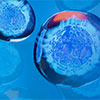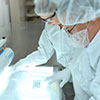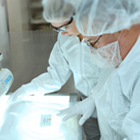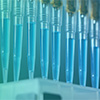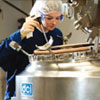Déioniseurs
Numéro de catalogue:
(BOSSBS-12290R-CY5)
Fournisseur:
Bioss
Description:
The RBM (RNA-binding motif) gene family encodes proteins with an RNA binding motif. RBMY (RBM, Y chromosome) encodes a germ-cell specific nuclear protein involved in spermatogenesis. The RBM gene family, including RBMY1A, RBMY1B, RBMY1D, RBMY1E, RBMY1F, RBMY1H and RBMY1J, is comprised of at least 30 genes and pseudogenes, found on both arms of the Y chromosome. RBM X, an ancestral X chromosome homolog of the RBMY gene, encodes hnRNP G, which is widely expressed, whereas the RBMY gene evolved a male-specific function in spermatogenesis. Micro-deletions of the AZFb region of the Y chromosome, which contains a number of RBMY genes, usually result in severe consequences for spermatogenesis. RBM expression is localized to the nuclei of germ cells and RBM interacts with Tra2beta. Tra2beta is a ubiquitous activator of pre-mRNA splicing, but is most highly expressed in testis, suggesting a role for RBM in Tra2beta-dependent splicing in spermatocytes. The human RBMX gene maps to chromosome Xq26 and the RBMY gene family is found on all mammalian Y chomosomes.
UOM:
1 * 100 µl
Numéro de catalogue:
(BOSSBS-9704R-A488)
Fournisseur:
Bioss
Description:
The Interferon family of proteins are able to alter the expression of a variety of target genes, thereby controlling various events within the cell. IFI-35 (Interferon-induced 35 kDa protein), also known as IFP35, is a 286 amino acid interferon-induced protein. Localized to the nucleus and expressed in macrophages, fibroblasts and epithelial cells, IFI-35 is a leucine zipper protein that can form homodimers, but, unlike most leucine zipper proteins, cannot bind DNA. Upon induction by IFN-? IFI-35 associates with Nmi (N-Myc-interacting protein), resulting in the formation of a high molecular weight complex that is thought to play a role in IFN-?signaling and cellular responses. Once complexed with Nmi, IFI-35 is unable to be degraded by the proteasome, suggesting that IFI-35 is protected from degradation only when needed by IFN-? Two isoforms of IFI-35 exist due to alternative splicing events.
UOM:
1 * 100 µl
Numéro de catalogue:
(BOSSBS-9704R-A350)
Fournisseur:
Bioss
Description:
The Interferon family of proteins are able to alter the expression of a variety of target genes, thereby controlling various events within the cell. IFI-35 (Interferon-induced 35 kDa protein), also known as IFP35, is a 286 amino acid interferon-induced protein. Localized to the nucleus and expressed in macrophages, fibroblasts and epithelial cells, IFI-35 is a leucine zipper protein that can form homodimers, but, unlike most leucine zipper proteins, cannot bind DNA. Upon induction by IFN-? IFI-35 associates with Nmi (N-Myc-interacting protein), resulting in the formation of a high molecular weight complex that is thought to play a role in IFN-?signaling and cellular responses. Once complexed with Nmi, IFI-35 is unable to be degraded by the proteasome, suggesting that IFI-35 is protected from degradation only when needed by IFN-? Two isoforms of IFI-35 exist due to alternative splicing events.
UOM:
1 * 100 µl
Numéro de catalogue:
(BOSSBS-9114R-CY5.5)
Fournisseur:
Bioss
Description:
Members of the BAGE gene family encode antigens that are recognized by cytotoxic T lymphocytes and are also known as CT (cancer/testis) antigens. Generated by juxtacentromeric shuffling of the MLL3 gene, the ancestral BAGE gene was expanded by acrocentric exchanges and/or juxtacentromeric movements.Generally, BAGE proteins are silent in all normal tissues with the exception of testis. BAGE2 and BAGE 3 (B melanoma antigen 2 and 3, respectively), also known as Cancer/testis antigen 2.2 and 2.3 (respectively), are 109 amino acid secreted proteins that are expressed in 22% of melanomas, lung and bladder carcinomas, and are also expressed in normal testis tissue. Like the genes encoding MAGE proteins, BAGE genes are most likely silenced by DNA methylation and/or chromatin compaction in normal tissues other than testis.
UOM:
1 * 100 µl
Numéro de catalogue:
(BOSSBS-8874R-A750)
Fournisseur:
Bioss
Description:
The G protein-coupled receptor TGR5 is a 330-amino acid protein that is almost universally expressed in human tissues including heart, skeletal muscle, spleen, kidney, liver, small intestine, placenta, and leukocytes, but not in brain, colon (without mucosa), thymus, or lung. TGR5 is sensitive to bile acids and responds through a significant mechanism that coordinates energy homeostasis. Bile acids activate mitogen-activated protein (MAP) kinase pathways, specifically induce TGR5 internalisation, promote an increase of guanosine 5'-O-3-thio-triphosphate binding in membrane fractions, and cause rapid intracellular cAMP production. Bile acids also provoke TGR5 to suppress macrophage functions. TGR5-controlled signaling pathways may be good candidates for drug targets to treat common metabolic diseases, such as obesity, type II diabetes, hyperlipidemia, and atherosclerosis.
UOM:
1 * 100 µl
Numéro de catalogue:
(BOSSBS-5324R-CY5)
Fournisseur:
Bioss
Description:
Receptor for TNFSF6/FASLG. The adapter molecule FADD recruits caspase-8 to the activated receptor. The resulting death-inducing signaling complex (DISC) performs caspase-8 proteolytic activation which initiates the subsequent cascade of caspases (aspartate-specific cysteine proteases) mediating apoptosis. FAS-mediated apoptosis may have a role in the induction of peripheral tolerance, in the antigen-stimulated suicide of mature T-cells, or both. The secreted isoforms 2 to 6 block apoptosis (in vitro).
UOM:
1 * 100 µl
Numéro de catalogue:
(BOSSBS-8874R-HRP)
Fournisseur:
Bioss
Description:
The G protein-coupled receptor TGR5 is a 330-amino acid protein that is almost universally expressed in human tissues including heart, skeletal muscle, spleen, kidney, liver, small intestine, placenta, and leukocytes, but not in brain, colon (without mucosa), thymus, or lung. TGR5 is sensitive to bile acids and responds through a significant mechanism that coordinates energy homeostasis. Bile acids activate mitogen-activated protein (MAP) kinase pathways, specifically induce TGR5 internalization, promote an increase of guanosine 5'-O-3-thio-triphosphate binding in membrane fractions, and cause rapid intracellular cAMP production. Bile acids also provoke TGR5 to suppress macrophage functions. TGR5-controlled signaling pathways may be good candidates for drug targets to treat common metabolic diseases, such as obesity, type II diabetes, hyperlipidemia, and atherosclerosis.
UOM:
1 * 100 µl
Numéro de catalogue:
(BOSSBS-12172R-HRP)
Fournisseur:
Bioss
Description:
Voltage-gated potassium (Kv) channels represent the most complex class of voltage-gated ion channels from both functional and structural standpoints. Their diverse functions include regulating neurotransmitter release, heart rate, insulin secretion, neuronal excitability, epithelial electrolyte transport, smooth muscle contraction, and cell volume. This gene encodes a member of the potassium channel, voltage-gated, isk-related subfamily. This member is a type I membrane protein, and a beta subunit that assembles with a potassium channel alpha-subunit to modulate the gating kinetics and enhance stability of the multimeric complex. This gene is prominently expressed in the embryo and in adult uterus. [provided by RefSeq, Jul 2008].
UOM:
1 * 100 µl
Numéro de catalogue:
(BOSSBS-5251R-HRP)
Fournisseur:
Bioss
Description:
Serine/threonine-protein kinase which is required for checkpoint-mediated cell cycle arrest and activation of DNA repair in response to the presence of DNA damage or unreplicated DNA. May also negatively regulate cell cycle progression during unperturbed cell cycles. This regulation is achieved by a number of mechanisms that together help to preserve the integrity of the genome. Recognizes the substrate consensus sequence [R-X-X-S/T]. Binds to and phosphorylates CDC25A, CDC25B and CDC25C. Phosphorylation of CDC25A at 'Ser-178' and 'Thr-507' and phosphorylation of CDC25C at 'Ser-216' creates binding sites for 14-3-3 proteins which inhibit CDC25A and CDC25C. Phosphorylation of CDC25A at 'Ser-76', 'Ser-124', 'Ser-178', 'Ser-279' and 'Ser-293' promotes proteolysis of CDC25A. Phosphorylation of CDC25A at 'Ser-76' primes the protein for subsequent phosphorylation at 'Ser-79', 'Ser-82' and 'Ser-88' by NEK11, which is required for polyubiquitination and degradation of CDCD25A. Inhibition of CDC25 leads to increased inhibitory tyrosine phosphorylation of CDK-cyclin complexes and blocks cell cycle progression. Also phosphorylates NEK6. Binds to and phosphorylates RAD51 at 'Thr-309', which promotes the release of RAD51 from BRCA2 and enhances the association of RAD51 with chromatin, thereby promoting DNA repair by homologous recombination. Phosphorylates multiple sites within the C-terminus of TP53, which promotes activation of TP53 by acetylation and promotes cell cycle arrest and suppression of cellular proliferation. Also promotes repair of DNA cross-links through phosphorylation of FANCE. Binds to and phosphorylates TLK1 at 'Ser-743', which prevents the TLK1-dependent phosphorylation of the chromatin assembly factor ASF1A. This may enhance chromatin assembly both in the presence or absence of DNA damage. May also play a role in replication fork maintenance through regulation of PCNA.
UOM:
1 * 100 µl
Numéro de catalogue:
(BOSSBS-15542R-A488)
Fournisseur:
Bioss
Description:
This gene encodes an enzyme that hydrolyses the terminal alpha-L-iduronic acid residues of two glycosaminoglycans, dermatan sulfate and heparan sulfate. This hydrolysis is required for the lysosomal degradation of these glycosaminoglycans. Mutations in this gene that result in enzymatic deficiency lead to the autosomal recessive disease mucopolysaccharidosis type I (MPS I).
UOM:
1 * 100 µl
Numéro de catalogue:
(BOSSBS-15543R-A350)
Fournisseur:
Bioss
Description:
Required for the lysosomal degradation of heparan sulfate and dermatan sulfate.
UOM:
1 * 100 µl
Numéro de catalogue:
(BOSSBS-15543R-A488)
Fournisseur:
Bioss
Description:
Required for the lysosomal degradation of heparan sulfate and dermatan sulfate.
UOM:
1 * 100 µl
Numéro de catalogue:
(BOSSBS-15541R-A750)
Fournisseur:
Bioss
Description:
This gene encodes the homolog of the Drosophila melanogaster Nipped-B gene product and fungal Scc2-type sister chromatid cohesion proteins. The Drosophila protein facilitates enhancer-promoter communication of remote enhancers and plays a role in developmental regulation. It is also homologous to a family of chromosomal adherins with broad roles in sister chromatid cohesion, chromosome condensation, and DNA repair. The human protein has a bipartite nuclear targeting sequence and a putative HEAT repeat. Condensins, cohesins and other complexes with chromosome-related functions also contain HEAT repeats. Mutations in this gene result in Cornelia de Lange syndrome, a disorder characterised by dysmorphic facial features, growth delay, limb reduction defects, and mental retardation. Two transcript variants encoding different isoforms have been found for this gene.
UOM:
1 * 100 µl
Numéro de catalogue:
(BOSSBS-3925R-A555)
Fournisseur:
Bioss
Description:
This is a membrane-bound, calcium-stimulable adenylyl cyclase. May be involved in learning, in memory and in drug dependence (By similarity).
UOM:
1 * 100 µl
Numéro de catalogue:
(BOSSBS-3955R-A555)
Fournisseur:
Bioss
Description:
Core subunit of the mitochondrial membrane respiratory chain NADH dehydrogenase (Complex I) that is believed to belong to the minimal assembly required for catalysis. Complex I functions in the transfer of electrons from NADH to the respiratory chain. The immediate electron acceptor for the enzyme is believed to be ubiquinone (By similarity).
UOM:
1 * 100 µl
Numéro de catalogue:
(BOSSBS-11403R-A555)
Fournisseur:
Bioss
Description:
Gonadotropin-releasing hormone (GnRH) is released in a pulsatile manner that varies with the reproductive cycle. This hypothalamic hormone is transported to the pituitary, where it binds to specific receptors and regulates the synthesis and release of luteinizing hormone (LH) and follicle-stimulating hormone (FSH). Localized to the cell membrane, GnRHR2 mediates its own receptor activity via association with G proteins, thereby activating a phosphatidylinositol-calcium second messenger system that regulates GnRHR2 function. GnRHR2 is thought to have potent antiproliferative effects on ovarian and endometrial cancer cells, suggesting a possible role in tumor suppression. Due to alternative splicing events, GnRHR2 is expressed as two isoforms.
UOM:
1 * 100 µl
Appel de prix
Le stock de cet article est limité mais peut être disponible dans un entrepôt proche de vous. Merci de vous assurer que vous êtes connecté sur le site afin que le stock disponible soit affiché. Si l'
Le stock de cet article est limité mais peut être disponible dans un entrepôt proche de vous. Merci de vous assurer que vous êtes connecté sur le site afin que le stock disponible soit affiché. Si l'
Ces articles ne peuvent être ajoutés au Panier. Veuillez contacter votre service client ou envoyer un e-mail à vwr.be@vwr.com
Une documentation supplémentaire peut être nécessaire pour l'achat de cet article. Un représentant de VWR vous contactera si nécessaire.
Ce produit a été bloqué par votre organisation. Contacter votre service d'achat pour plus d'informations.
Le produit original n'est plus disponible. Le remplacement représenté est disponible
Les produits marqués de ce symbole ne seront bientôt plus disponibles - vente jusqu'à épuisement de stock. Des alternatives peuvent être disponibles en recherchant le code article VWR indiqué ci-dessus. Si vous avez besoin d'une assistance supplémentaire, veuillez contacter notre Service Clientèle au 016 385 011.
|
|||||||||||||||




